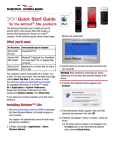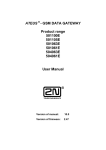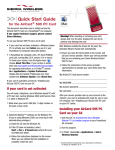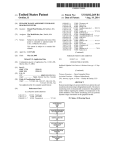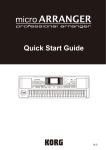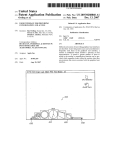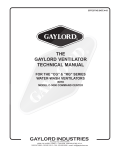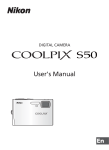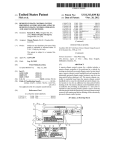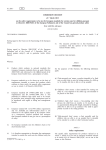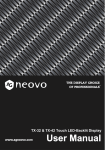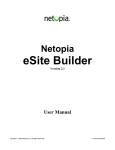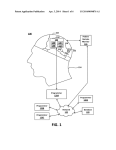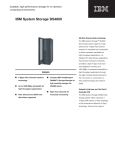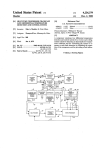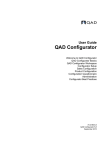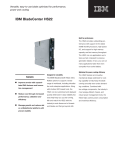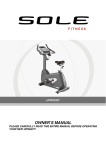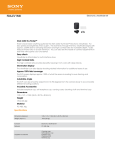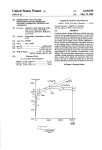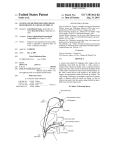Download User interface for providing consolidation and access
Transcript
US 20140143723A1
(19) United States
(12) Patent Application Publication (10) Pub. No.: US 2014/0143723 A1
Ording et al.
(54)
(43) Pub. Date:
USER INTERFACE FOR PROVIDING
CONSOLIDATION AND ACCESS
May 22, 2014
8,032,843, which is a continuation of application No.
11/892,153, ?led on Aug. 20, 2007, now Pat. No.
7,526,738, which is a continuation of application No.
(71) Applicant: Apple InC-, CupeItiHO, CA (US)
09/467,074, ?led on Dec. 20, 1999, now Pat. No.
7,434,177.
(72) Inventors: Bas Ording, San Francisco, CA (US);
Steven P. Jobs, Palo Alto, CA (US);
Donald J. Lindsay, Mountain View, CA
(US)
Publication Classi?cation
(51) Int. Cl.
(73) Assignee: Apple Inc., Cupertino, CA (US)
(52)
G06F 3/0484
(2006.01)
G06F 3/0482
(2006.01)
US. Cl.
(21)
Appl. No.: 14/164,922
CPC ........ .. G06F 3/04842 (2013.01); G06F 3/0482
(22)
Filedr
USPC ........................................................ .. 715/823
(2013.01)
Jan- 27, 2014
Related US. Application Data
(63)
(57)
Continuation of application No. 13/252,227, ?led on
Oct. 4, 2011, now Pat. No. 8,640,044, Continuation of
application No. 13/252,232, ?led on Oct. 4, 2011, now
ABSTRACT
Methods and systems for providing graphical user interfaces
are described. To provide greater access and consolidation to
Mar. 24, 2009, now Pat. No. 8,032,843, said applica
tion No. 13/252,232 is a continuation of application
frequently used items in the graphical user interface, a userbar
is established which includes a plurality of item representa
tions. To permit a greater number of items to reside in the
userbar, a magni?cation function can be provided which mag
ni?es items within the userbar when they are proximate the
No. 12/410,354, ?led on Mar. 24, 2009, now Pat. No.
cursor associated with the graphical user interface.
Pat. No. 8,640,045, said application No. 13/252,227 is
a continuation of application No. 12/410,354, ?led on
E] File Edit Image Layer Select Filter View Window C3
UFO Newsletter
UserBar Settings
?le size: c@::3
small
large
IKE}
Atomic Sonic
Magnification: 0 never
Owhen necessary
Q always to:
720 X
:C)
small
large
Show 8: Hide: Q always visible
O autohide
O hotkey:
[
600
Patent Application Publication
May 22, 2014 Sheet 1 0f 6
[FILE EDIT VIEW SPECIAL COLOR
US 2014/0143723 A1
K75
[#50
5121:: MY‘ DOCUMENTS ~————__-___—-—
755, 56
5,:
DOCUMENT 1
55
DOCUMENT 3
57\E‘T
D:
DOCUMENT 2
58
DOCUMENT 4
I
T
50
)X
70’]
/
20
FIG, TA (PRIOR ART)
75
20
\
F FILE EDTT VIEW SPECIAL COLOR
1
'
(,65
?60
74\£T::_____————-— MY DOCUMENTs— w
DOCUMENT 1
DOCUMENT 3
W57
47
E1
:5 505x 5 “L51
, W55
70
\
n
59
30
HQ, 75 (PRIOR ART)
N
T
Patent Application Publication
May 22, 2014 Sheet 2 0f 6
US 2014/0143723 A1
f 270
\200
230
f
220
i
'
ifDI
sm?vaword Promi/meing ProgIESpreud Shee’c‘
FIG, 2 (PRIOR ART)
J 500
D 600
o ser
FIG. 3 (PRIOR ART)
Patent Application Publication
May 22, 2014 Sheet 3 0f 6
S 407
/
{402
US 2014/0143723 A1
540.3
§404
PROCESSOR
RANDOM
ACCESS
MEMORY
READ
ONLY
MEMORY
DATA
STORAGE
DEVICE
I
T
|
I
T
400
Dgg?légg
L405
l
l
I
ALPHA—
CURSOR
SIGNAL
NUMERIC
CONTROL
GENERA TION
INPU T DEVICE
DE VICE
DE VICE
L406
L407
L408
FIG. 4
512
504
Patent Application Publication
U
May 22, 2014 Sheet 4 0f 6
US 2014/0143723 A1
.lJ 2EC3o<m
E:
2936.52
QQm\N
QBQNQSvmQWQ
A
m
V
\
@
UE®LITBE
QmisEE2a55252$9525OE;
Patent Application Publication
May 22, 2014 Sheet 5 0f 6
QQQ
U9L@256 QB 285m%
282
Bmcwh:m
H@5E%U
=95
"COOM$E5C:QVE
OH
$92
5:8;0:“2QAquQ :35
mUPE.2m32552%23.in3%;E>
Rm/
£2202%;5%Q621um“
05:25 5520
US 2014/0143723 A1
Patent Application Publication
FIG, 8A
H
<
W
H
W
i
Q33 \
800
670
f’r 4 d2: 6510
w
80"
800
US 2014/0143723 A1
V570
hi
806/
I]
May 22, 2014 Sheet 6 0f 6
\& \
FIG. 8G
FIG. 89
670
May 22, 2014
US 2014/0143723 A1
USER INTERFACE FOR PROVIDING
CONSOLIDATION AND ACCESS
puter information. The main or root window is called the
CROSS REFERENCE TO RELATED
APPLICATIONS
played on the screen with its contents accessible or at least
“desktop” area, or more generally the primary display region.
The desktop, or primary display region, is always open (dis
[0001] This is a continuation of application Ser. No.
12/410,354, ?led Mar. 24, 2009, now US. Pat. No. 8,032,843,
issued Oct. 4, 2011, which is a continuation of application
Ser. No. 11/892,153, ?led Aug. 20, 2007, now US. Pat. No.
7,526,738, issued Apr. 28, 2009, which is a continuation of
application Ser. No. 09/467,074, ?led Dec. 20, 1999, now
US. Pat. No. 7,434,177, issued Oct. 7, 2008.
BACKGROUND
[0002]
The present invention relates generally to graphical
user interfaces for computer systems. More particularly, the
present invention relates to systems and methods for interfac
ing applications and operating systems which provide for
partially accessible), and takes up substantially the fall dis
play screen area when other windows are not open. The
desktop is usually visible in the background when other win
dows are open.
[0007] Existing inside any particular window, including the
desktop itself, are other information identi?ers called “icons.”
An icon is a screen identi?er associated with a particular
collection of computer information. Typically an icon may
represent a “?le” which is either a collection of data or a
program or program segment. An icon also may represent the
closed state of a window. Icons are graphic images displayed
on the computer screen and usually correspond to the type of
information stored within the ?le. Icons give the user access
to the particular ?le represented by the graphic image when
?exible customization of graphical user interfaces.
the icon is visible. The use of icons and windows is well
known in the art.
[0003] The evolution of the computer industry is unparal
leled in its rate of growth and complexity. Personal comput
[0008] The “?le” is the information packet that the user
wishes to utilize, create or modify; each particular ?le has an
ers, for example, which began as little more than feeble cal
associated name identifying the ?le. Therefore, any given ?le
may be located in the information management system by
knowing a ?le name, an iconographic representation associ
culators with limited memory, tape-driven input and
monochrome displays are now able to tackle almost any data
processing task. While this meteoric increase in power was
almost suf?cient to satisfy the demand of application design
ers and end users alike, the corresponding increase in com
plexity created an ease-of-use problem which the industry
was somewhat slower in solving. Thus, designers were faced
ated with the name, or a window locator name. All informa
tion (?les) situated within a particular window are identi?ed
with that particular window’s own identi?cation location
within the computer information management system. There
fore, any particular ?le information can be retrieved knowing
with a new challenge: to harness this computing power in a
its particular identi?cation name and its window name.
form usable by even those with relatively little computer
Accordingly, the resulting screen display utiliZing the
training to smooth the transition of other industries into a
FinderTM user interface may be broken down into multiple
computer-based information paradigm.
windows and graphic icons.
[0009] Another important element of this (and other) con
[0004] As a result, in the early to mid-1980’s many new I/O
philosophies, such as “user friendly”, “WYSIWYG” and
“menu driven” came to the forefront of the industry. These
concepts are particularly applicable to microcomputers, also
known as personal computers, which are intended to appeal to
a broad audience of computer users, including those who
ventional user interfaces is a screen cursor. The cursor allows
direct user control over the user interface as described above.
The FinderTM user interface is complemented with a “mouse”
and a corresponding “pointer” which makes up the cursor
control device. The user has control over the mouse, which is
an electro -mechanical device that translates two -dimensional
previously feared and mistrusted computers. An important
aspect of computers which employ these concepts was, and
mouse movement into a two-dimensional screen position
continues to be, the interface which allows the user to input
movement represented by, for example, a pointer or arrow
commands and data and receive results, which is commonly
head. The user contacts and directs the mouse. When the
mouse is moved freely on a table top, then the pointer on the
referred to as a graphical user interface (GUI).
[0005]
The success of this type of interface is evident from
the number of companies which have emulated the desktop
environment. Even successful concepts, however, must con
tinually be improved in order to keep pace with the rapid
growth in this industry. The advent of multimedia, especially
CD-ROM devices, has provided vast quantities of secondary
storage which have been used to provide video capabilities,
screen will move in a similar and proportional manner. The
mouse also contains one or more push buttons which can be
used to effectuate control over the cursor pointer by selecting
or deselecting speci?c icons or other display tools. It is said
that the cursor pointer is “activated” when the mouse button is
depressed and the pointer remains active until the button is
released. Pointer activation may also be initiated by
e.g., live animation and video clips, as regular components of
sequences of mouse button presses, such as a “double click”
application displays. With these and other new resources at
interaction which involves rapidly pressing the mouse button
their disposal, application designers and users alike, demand
press twice in sequence.
additional functionality and greater ease of use from the desk
[0010]
top environment.
[0006] To consider the challenges associated with continu
face system for a display management system is therefore
Access to information in a conventional user inter
FinderTM user interface is based on the aforedescribed display
based on windows, icons and pointer movement of the cursor.
To access a ?le, the cursor pointer is placed on the visible icon
or visible ?le name and the pointer is activated. A closed
window may be represented by an icon or a window name. A
window opens when the pointer of the cursor rests on the
visible icon or visible name representing the closed state of
principles using “windows” and “icons” to help manage com
the window and the pointer is activated. Within the open
ing GUI design, consider as an example of a GUI which has
evolved over time the FinderTM user interface and information
management system (simply “FinderTM user interface” here
after) which runs on the Apple MacintoshTM computer. The
May 22, 2014
US 2014/0143723 A1
window, of various geometries, may be rectangular and will
open window 60 containing several document icons 55-58
which are, therefore, accessible for operations by the user via
exist within the display area of the main viewing screen on the
cursor 50. The window 60 also includes a window title ?eld
desktop. Multiple windows may be open at one time, typi
cally with the most foreground window corresponding to the
most recently opened window and the background windows
65 and window select region 74.
[0015] When activated, e.g., by placing cursor 50 over
handle 10, the Desk Drawer “opens” to reveal its contents. In
this case, icons 41, 42, 51 and 59 become visible. Now that
these icons are visible, they too are available for manipulation
by the user via cursor 50. Thus, the Desk Drawer concept
provides a mechanism for placing frequently used icons in an
out of the way, yet easily accessible location. The interested
reader is directed to US. Pat. No. 5,657,049, entitled “Desk
window, ?les may be displayed by icon or by name. An open
representing those opened previously. In the organization
scheme described, it is appreciated that ?les are nested within
windows and windows can be nested within other windows;
the main or root window being the desktop area, or primary
display region.
[0011]
During a session using a window-based information
system, many windows can be open at one time with many
Drawer User Interface” for a more in depth discussion of this
displayed icons within. Windows may overlap and partially,
technique, the disclosure of which is incorporated here by
or entirely, hide other windows or icons. What results is that
the particular information the user wants to obtain may be
reference.
hidden behind several layers of windows and may be dif?cult
to access; when an icon is hidden by another window it is
temporarily not accessible. This has been referred to in the
industry as the “window overlap” problem. There are several
instances where window overlap problems routinely arise in
the usage of conventional user interfaces. A few of the more
troublesome scenarios are described below.
[0012] In order to complete a task, often the user must
access a' single icon within an open window that exists in the
[0016] Another conventional GUI, i.e., that provided with
the WINDOWS 95 Operating System, tackles the problem of
desktop clutter by the provision of a taskbar to organize
concurrently running applications as shown in FIG. 2.
Therein, the desktop window 200 includes a plurality of icons
210 as well as the taskbar 220. The icons 210 provide “short
cuts” to applications or documents which can be invoked,
e.g., by “double-clicking” on the desired icon. The taskbar
220 identi?es windows which are active including both those
which are maximized and “minimized”, i.e., are not currently
background, that is, covered or partially covered by other
windows. The desired icon (“target” icon) within the window
is no longer visible, and therefore not presently accessible.
The overlapping windows or those that lay “on top of” the
tion as well as some descriptive text. As new applications axe
target window must be closed or moved away (“shuf?ed”) so
that the target window and target icon are visible and thus
launched, representative buttons will be added to the taskbar
220, from left to right. Each existing button will be scaled in
accessible. Window shuf?ing is time consuming, confusing
need to be systematically accessed in sequence then multiple
length to permit the taskbar to accommodate new buttons. To
“maximize” an application residing on the taskbar 220, the
user can single click on the representative button. Another
window shuf?ing procedures may be required.
[0013] Another window overlap problem plaguing conven
application bars, e.g., appbar 230. Appbar 230 typically
and often very tedious for the user. If multiple routine icons
tional user interfaces arises when the user requires two icons
to complete a task and each icon is within a different window.
displayed on the desktop 200. Each such active application is
represented on the taskbar 220 by a corresponding button,
which typically has an iconic representation of the applica
feature sometimes seen in this type of conventional GUI are
includes a number of smaller buttons (relative to the length of
buttons on the taskbar when only a few applications are resi
dent there), which buttons can be depressed to launch a cur
The resulting screen display may contain several open win
dows from past tasks that may clutter the screen display with
unwanted information. This information may obscure the
desired windows and icons. In many instances the overlap
ping windows are not unwanted, but hold the ?rst of the
the user cannot select or organize the order of the buttons on
desired icons in displayable view. In order to access the sec
the taskbar 220) and from dif?culties in handling the repre
ond desired icon, the user may close the overlapping window
that holds the ?rst icon, then gain access to the second desired
icon. Since the previously closed window holds the ?rst
desired icon it must be opened again so that the present task
can be completed. Again, this process is often time consum
sentation of a large number of applications. As more buttons
are added to the taskbar 220, each individual button becomes
ing and confusing for the user4especially when the hidden
second icon is one that is routinely required. In this case the
user is engaged in constant “window shu?ling” as described
above.
[0014] Not surprisingly, these types of problems have
received a signi?cant amount of attention in recent years.
Several user interface products have been developed which
provide different solutions to the manner in which frequently
used and currently active desktop objects are handled by the
GUI. For example, consider the conventional GUI depicted in
FIGS. 1(a) and 1(b). Therein, a “Desk Drawer” concept is
implemented to provide selectively hideable access to fre
quently used desktop objects. FIG. 1(a) depicts the screen 75
having a desktop area 20 with the Desk Drawer closed,
wherein only the handle 10 of the Desk Drawer is visible. An
rently inactive application.
[0017] This conventional GUI, however, suffers from the
drawbacks of having a rather rigidly structured layout (e.g.,
smaller. When, for example, between 20-30 applications have
been launched and minimized, the taskbar 220 begins to add
new buttons as a second layer rather than continuing the line
of buttons illustrated in FIG. 2. To reach the second layer, the
user must toggle the taskbar 220, i.e., not all of the buttons are
visible simultaneously on the GUI. As the power of comput
ers and number of interesting applications, documents and
other objects increases, it is anticipated that users will wish to
have ready access to a growing number of objects and, there
fore, will ?nd the approach depicted in FIG. 2 to be annoying
and ineffective.
[0018] Another conventional GUI which attempts to solve
this particular problem can be found in the NeXTTM Operat
ing System. As illustrated in FIG. 3, and further described in
US. Pat. No. 5,146,556, entitled “System and Method for
Managing Graphic Images” (the disclosure of which is also
expressly incorporated here by reference), this GUI provides
an application “dock” 300 including a column of icons on the
May 22, 2014
US 2014/0143723 A1
BRIEF DESCRIPTION OF THE DRAWINGS
right side of the screen 310. The dock 300 is described as
providing a visible mechanism for starting applications. Icons
can be added and deleted to the application dock 300 by
dragging them into a desired location proximate the docking
area, at which time the operating system will integrate them
into the dock 300.
[0019] Although somewhat more ?exible in terms of allow
ing the user to organize its content than the taskbar/appbar of
FIG. 2, the application dock 300 still suffers from its limita
tions in terms of the number of applications which can be
docked at any one time. The icons in the dock are of a ?xed
size and, according to the user manual, are therefore limited to
a maximum of 13 which can be included in the dock at any
one time.
[0020] Thus, it can be seen that there remains a need in the
art to design a GUI which provides the user with a larger
degree of ?exibility in terms of both the layout of the tool
which manages these types of frequently used objects, as well
as permitting a larger number of such objects to be managed
and simultaneously displayed.
SUMMARY
[0021] According to exemplary embodiments of the
present invention, these and other drawbacks and dif?culties
of conventional GUIs are overcome by providing a simple,
[0024] These and other objects, features and advantages of
the present invention will be readily understood by those
skilled in the art by reading the following detailed description
in conjunction with the drawings, in which:
[0025] FIGS. 1(a) and 1(b) depict a ?rst, conventional user
interface;
[0026] FIG. 2 depicts a second, conventional user interface
which employs a taskbar and an appbar to handle objects;
[0027] FIG. 3 depicts a third, conventional user interface
which employs an application dock;
[0028] FIG. 4 is a block diagram of an exemplary system in
which the present invention can be implemented;
[0029] FIG. 5 is an exemplary computer system which may
contain the functional blocks of FIG. 4 and in which the
present invention can be implemented;
[0030]
FIG. 6 illustrates a user interface including a userbar
according to an exemplary embodiment of the present inven
tion;
[0031] FIG. 7 depicts the user interface of FIG. 6 with the
cursor disposed at another location within the userbar region
on the screen; and
[0032]
FIGS. 8(a)-8(d) describe an exemplary magni?ca
tion effect mechanism according to an exemplary embodi
ment of the present invention.
consolidated and easily extensible facility for handling, for
example, frequently used objects. For example, user inter
faces according to the present invention provide a tool (re
[0033] In the following description, for purposes of expla
ferred to herein as the “userbar”) which consolidates features
nation and not speci?c details are set forth, such as particular
including: launching and managing running applications;
opening and managing documents and their associated win
dows; accessing control strip functionality; navigation to all
types of uniform resource locators (URLs); and status and
noti?cation on running processes.
DETAILED DESCRIPTION
circuits, circuit components, techniques, etc. in order to pro
vide a thorough understanding of the present invention. How
ever, it will be apparent to one skilled in the art that the present
As mentioned above, existing tools of this type, such
invention may be practiced in other embodiments that depart
from these speci?c details. In other instances, detailed
descriptions of well-known methods, devices, and circuits are
as taskbars and docks, are constrained in one or more of at
omitted so as not to obscure the description of the present
least two ways: having a rigidly structured layout and being
limited in the number of obj ects that they can represent in the
invention.
available screen space. With respect to layout, the userbar
according to the present invention is designed so that the
organization of the userbar is in the hands of the user. For
can be implemented on an Apple MacintoshTM computer
[0022]
example, the tiles that represent the individual items in the
userbar can be reorganized at will. There is virtually no struc
ture enforced on the user, with the exception of two “book
ends” which de?ne boundaries of the facility.
[0023] With respect to screen space, the userbar according
to the present invention provides a method for scaling the
entire contents of the object handling facility such that liter
ally upwards of ?fty objects (or more) can be accommodated
in a single, visible structure. As the objects handled by the
userbar become rather small, e.g., due to the size set by the
user or due to a large number of objects being added thereto,
it naturally becomes more difficult to distinguish between
[0034]
Exemplary embodiments of the present invention
system using the FinderTM user interface. However, it will be
readily appreciated by those skilled in the art that user inter
faces and elements of user interfaces according to the present
invention can be used in combination with any system having
a processor and a display. In general, such computer systems,
as illustrated in block diagram form by FIG. 4, comprise a bus
400 for communicating information, a processor 401 coupled
with the bus for processing information and instructions, a
random access memory 402 coupled with the bus 400 for
storing information and instructions for the processor 401, a
read only memory 403 coupled with the bus 400 for storing
static information and instructions for the processor 401, a
data storage device 404 such as a magnetic disk and disk drive
or CD ROM drive coupled with the bus 400 for storing infor
different tiles. Accordingly, exemplary embodiments of the
present invention provide a magni?cation effect, also referred
bus 400 for displaying information to the computer user, an
to herein as a ?sheye effect, for browsing the scaled contents
of the userbar. This mechanism allows speci?ed contents of
function keys coupled to the bus 400 for communicating
the userbar, in particular minimized windows, to be presented
at a larger size and in greater detail and legibility than other
objects in the userbar. This feature permits, among other
things, the individual tiles of the tool to retain their legibility
and prevents the user interaction with the tool from being
compromised by the scaled contents.
mation and instructions, a display device 405 coupled to the
alphanumeric input device 406 including alphanumeric and
information and command selections to the processor 401, a
cursor control device 407 coupled to the bus for communi
cating information and command selections to the processor
401, and a signal generating device 408 coupled to the bus
400 for communicating command selections to the processor
401.
May 22, 2014
US 2014/0143723 A1
[0035] The display device 405 utilized with the computer
system and the present invention may be a liquid crystal
device, cathode ray tube, or other display device suitable for
creating images and alphanumeric characters (and ideo
graphic character sets) recognizable to the user. The cursor
control device 407 allows the computer user to dynamically
signal the two dimensional movement of a visible symbol
(cursor) on a display screen of the display device 405. Many
implementations of the cursor control device are known in the
art including a trackball, mouse, joystick or special keys on
a user’s preferences and will, therefore, naturally vary from
one user to the next. Any type of item or object may be
handled by the userbar 600, however a few examples, includ
ing applications, document ?les and windows will now be
described in order to illustrate how exemplary userbars
according to the present invention may represent and manipu
late various items.
[0039] Applications can be presented on the userbar 600 by,
for example, one of two methods. First, the application’s icon
can be added to the userbar 600 as a permanent ?xture, e.g.,
the alphanumeric input device 406 capable of signaling
for most frequently launched applications. Alternatively, the
movement of a given direction or manner of displacement. It
is to be appreciated that the cursor also may be directed and/or
application may not be a permanent ?xture of the userbar 600,
but may be added thereto because it is currently running. Such
non-permanent applications may be represented in the user
bar 600 only while the application remains running and may
be removed automatically by the GUI when the application is
terminated. Faceless background applications, e. g., virus pro
tection applications, if not launched from the userbar 600,
activated via input from the keyboard using special keys and
key sequence commands. Alternatively, the cursor may be
directed and/ or activated via input from a number of specially
adapted cursor directing devices, including those uniquely
developed for the disabled. In the discussions regarding cur
sor movement and/ or activation within the preferred embodi
need not be represented on the userbar 600 while they are
ment, it is to be assumed that the input cursor directing device
or push button may consist any of those described above and
running. Similarly, application sub-processes, such as a
speci?cally is not limited to the mouse cursor device.
the userbar 600.
[0040] Document ?les can also be placed on the userbar
[0036] FIG. 5 illustrates an exemplary computer system
that in which the present invention can be implemented. It
will be appreciated that this computer system is one of many
computer systems that may can include the present invention.
Therein, a keyboard 500 with keys 502 and keypad 504 is
attached to the computer 506 along with a mouse device 508
Finder copy, need not appear as a separate application tile on
600. This includes, for example, editable, non-editable (i.e.,
read only) and stationary ?les. An application’s “set” ?les
(e.g., Location Manager sets) can also be placed on the user
bar 600, but may only be useful to the user as part of the
userbar 600 if selecting one of these tiles would initiate a set
and mouse push button(s) 510 for controlling the cursor. The
change. A user may choose to place multiple copies of a
mouse device 508 and push button 510 make up a cursor
document onto the userbar 600, but the userbar 600 will
control device 407. It will be appreciated that many other
preferably only include a single representation of each object
devices may be used as the cursor control device 407, for
instance the keyboard 500 may be substituted for the mouse
in a particular state. For example, if a tile representing a folder
is disposed on the userbar 600 and the user opens that folder,
device 508 and button(s) 510 as just discussed above. The
this can result in the ?le management system (e.g., Finder)
computer 506 also typically contains a one or more media
opening (or navigating to) the directory represented by the
drives 511 (e.g., ?oppy disk, hard disk or CD ROM) and a
folder. If the user then minimizes that ?le management sys
display screen 512.
tem window, the originating userbar object is then presented
[0037] Having described exemplary computer systems in
which user interfaces according to the present invention can
be implemented, the discussion now turns to a description of
such user interfaces. According to exemplary embodiments
of the present invention, a userbar is provided to the user
interface which solves many of the problems described above
with respect to conventional user interface tools and facilities
by providing extensibility, scalability and ?exibility which
are lacking in prior systems.
Userbar Contents
[0038]
An example of the userbar according to the present
invention can be seen in the user interface of FIG. 6. Other
examples are seen in subsequent ?gures which will be further
described below. Therein, the userbar 600 includes a number
on the userbar 600 as a minimized window (e.g., as a folder
icon). Likewise, if a document is opened from the userbar 600
and its window is subsequently minimized by the user, it is
preferable that a representation of the minimized window
replace the image used for the originating document’s tile,
rather than adding a second tile to the userbar 600 for that
object.
[0041]
Document windows, when minimized by the user,
are placed on the userbar 600 and remain there until either
closed or maximized, which process is described in more
detail below under the section entitled “Userbar Functional
ity”. The image appearing on the tile can be, for example,
either: 1) a dynamically scaled representation of the actual
window contents, or 2) an appropriate image provided by, for
example, the application, such as the window’s proxy icon.
varies based on the position of the cursor 610 in a manner to
For example, a minimized Finder window might more appro
priately be presented as a folder icon, e.g., icon 620 in userbar
600, as opposed to providing a scaled image of the Finder
be described below in the section entitled “Userbar Appear
window’s content on the userbar 600.
(in this example sixteen) of tiles aligned along a bottom
portion of a user interface, the magni?cation level of which
ance”. The contents of the userbar 600 may represent a user
[0042]
selected (or alternatively, an application or operating system
selected) set of “super-favorite” items, i.e., items that the user
dows, many other types of items may reside on userbar 600.
has determined deserve greater ease-of-access than their
broader collection of favorite items, which could be numer
ous. The straightforward con?guration mechanism of the
userbar 600 according to the present invention facilitates
frequent changes to its contents, which contents are based on
In addition to applications, documents and win
For example, any type of system-supported uniform resource
locator (URL) ?le types can be placed on the userbar 600
including, but not limited to, ?le types having the extensions:
http, ftp, news, mailto, at, afp and ?le. Additionally, devel
oper-de?ned preference or setting modules (e.g., a slider con
trol to adjust the computer’ s speaker volume) can be added to
May 22, 2014
US 2014/0143723 Al
the userbar 600 by the user. Adding such preference or setting
modules to the userbar 600 may be accomplished by, for
may or may not be permitted to relocate the userbar 600 from
example, dragging pre-de?ned objects from the Finder to the
its default position.
bar.
[0043]
600. Depending upon the desired implementation, the user
[0047]
According to exemplary embodiments of the
present invention, two items are permanent ?xtures of the
userbar 600. These items, denoted by reference numerals 630
In terms of the size of the userbar 600, according to
this purely illustrative exemplary embodiment, the userbar
600 has a default size of 64x64 pixels. This default height may
change at locations associated with the cursor position as
and 640, act as “bookends” that contain the contents of the
userbar 600 between them. Those skilled in the art will appre
ciate that the selection of speci?c tiles to act as bookends may
described below in the section entitled “Variable Magni?ca
tion of Userbar Tiles”. A gap of a few pixels may be provided
between the bottom of the userbar 600 and the bottom of the
vary from implementation to implementation of the present
invention. However, in the purely illustrative exemplary
embodiments described herein the 630, which represents the
the height of the bar to remain partially visible. Alternatively,
the userbar may be provided at the very bottom of the display
Finder process and its window list, is provided as the left
bookend of the userbar 600. This the 630 represents the run
space such that no gap exists. In fact, the userbar 600 may be
located in any desired space on the display.
screen to allow windows that are placed, or dragged, below
ning Finder process and, according to this exemplary embodi
[0048]
ment, no other tiles may be placed on the userbar 600 to the
embodiments, the topmost window on the screen, i.e., all
other windows appear behind the userbar 600. Applications,
left of this object. Similarly, a tile 640 representing the trash
object acts as the right bookend of the userbar 600 in this
The userbar 600 is, according to these exemplary
when creating or zooming document windows, should place
exemplary embodiment. This the may replace any other
iconic representation of the trash object on the desktop GUI.
the bottom of the document window above the top of the bar
Acting as the right bookend, the user will not be able to place
any other tiles on the userbar 600 to the right of this object.
userbar 600 which would otherwise overlay the newly created
[0044] In addition to the two exemplary, permanent ?xtures
on the userbar 600 represented in this example by tiles 630
and 640, other prede?ned content may be placed on the user
bar 600 at either the user’s discretion or in a manner which is
prede?ned by the GUI. Candidate items for such permanent
residency on the userbar 600 include, for example, applica
tion folders, favorites, address book, clock, web browser and
e-mail applications.
Userbar Appearance
so as not to obscure any portion of the window with the
window.
[0049] Each tile can have a label associated therewith. For
example, in FIG. 6 the label “Clock” can be seen centered
above tile 610. Those skilled in the art will appreciate that the
label could alternatively be displayed below the correspond
ing tile. According to exemplary embodiments of the present
invention, labels for each tile are only visibly displayed on the
monitor while the cursor is proximate the corresponding tile.
For example, as the cursor moves into a region associated
with a particular tile, the label associated with that the is
displayed. When the cursor moves out of this region, the tile
label will vanish. Tile labels, when made visible or invisible,
can do so in a manner which makes them appear to fade in or
[0045] Exemplary embodiments of the present invention
provide various mechanisms which impact the appearance of
the userbar 600 in a manner which is intended to aid in
achieving the aforementioned objectives of providing a
simple, consolidated and easily extensible facility for han
dling frequently used objects. The userbar 600 can be imple
fade out. In current embodiments of the present invention,
when the cursor 610 enters the userbar region, a fade in time
of zero milliseconds is provided, although those skilled in the
art will appreciate that this value may be changed. In fact, the
fade in and fade out values mentioned herein may be user
changeable, e.g., using the user preferences dialog box
mented as a single horizontal row of items, or “tiles”, each of
described below with respect to FIG. 7.
which represent a particular object or process. Any state
which is supported for each object or process in the operating
system should also be supported on the userbar 600 by pro
viding a different appearance for each state. For example, a
tile disposed in userbar 600 can change its appearance as it
userbar 600, the appropriate tile label fades in while the
previous tile label fades out. Current embodiments of the
present invention provide, however, provide a value of zero
milliseconds for fading in and fading out of the tile labels as
moves from one state, e.g., selected, to another state, e.g.,
open or o?line. This allows the user to quickly recognize the
current state of each of the items on the userbar 600. Currently
executing applications can be indicated by, for example, plac
ing an LED-like indicator graphic above or below the corre
sponding application’s tile or icon. Applications can also
supply additional tile images to be substituted for, or com
posited on, the running application’s tile in the userbar 600.
[0050]
As the cursor 610 continues to roll across tiles on the
the cursor moves across the userbar 600. If the cursor 610
leaves the userbar 600, the last label presented persists for a
short period, e.g., 250 milliseconds, then fades out. Although
this exemplary embodiment of the present invention is
described in the context of only displaying a single label at a
time, those skilled in the art will appreciate that this feature of
the present invention may be readily adapted to varying
implementations. For example, the tile labels associated with
For example, an e-mail application’s tile can present the
number of new messages, superimposed over the applica
tion’s icon.
the current tile over which the cursor is positioned, as well as
[0046] According to exemplary embodiments of the
present invention, the default position of the userbar 600 is
displayed may be user settable.
anchored to the bottom of the main monitor and centered
present invention, in order to assist the user in managing the
userbar’s contents, separator tiles can be provided. These
colored or translucent separator tiles can be placed between
existing tiles to provide a visual distinction between groups of
horizontally therein. Thus, the userbar 600 maintains a posi
tion aligned relative to the horizontal center of the screen,
regardless of the number of items or tile placed in the userbar
the two tiles to either side of the current tile, could be simul
taneously displayed. Again, the number of the labels being
[0051]
According to another exemplary embodiment of the
May 22, 2014
US 2014/0143723 A1
(e.g., 16 pixels).
level is user-selectable as described below). For example, if
the default size of the tiles is 64 pixels, but the tile on which
the cursor is currently positioned has been scaled up to 128
Variable Magni?cation of Userbar Tiles
pixels due to the magni?cation effect, then this effect will not
end until the cursor leaves the 128 pixel top boundary of the
tiles. For example, the separator tiles may be provided as a
half-width tiles (e.g., 32 pixels) and/or quarter-width tiles
[0052] As mentioned above, a signi?cant bene?t of the
present invention may be found in the ability to permit a large
number of tiles to reside in a single row of the userbar 600. Of
course, the number of tiles which can ?t in the userbar 600 in
a single row is dependent upon the screen size and the size of
each individual tile. Since screen sizes are ?xed, the only way
to increase the number of tiles in the userbar 600 is to reduce
their size. However, at some relatively small size, the images
in each the will not be distinguishable by the user. Exemplary
embodiments of the present invention address this problem
by providing for variable magni?cation levels as between
different tiles on the userbar 600.
[0053]
Referring again to the exemplary embodiment illus
trated in FIG. 6, it will be seen that a cursor 610 rests on top
of one tile in the userbar 600, i.e., the tile having the descrip
tive legend “Clock” thereabove. It will immediately be rec
ognized that the “Clock” tile on which the cursor 610 rests has
been magni?ed to be larger than the surrounding tiles in the
userbar 600. This magni?cation is attributable to the “?sh
eye” effect which can be provided to the userbar 600 accord
ing to exemplary embodiments of the present invention.
[0054] In this particular exemplary embodiment, not only is
the tile upon which cursor 610 rests magni?ed, but so are
surrounding tiles. The amount of magni?cation can vary as
between tiles proximate the cursor position. In this example,
the magnitude of the magni?cation level is a function of the
distance of each tile edge from the cursor 610. Of course those
skilled in the art will appreciate that there are many different
types of magni?cation techniques and algorithms which can
be employed to provide this type of functionality. For
example, any number of tiles to either side of that over which
the cursor is resting could experience some level of magni?
cation. Alternatively, only the individual tile over which the
cursor is resting can be magni?ed. The level (percentage) of
magni?cation of each tile can also be varied in any desired
userbar 600.
[0057] Also seen in FIG. 7 is an exemplary userbar settings
screen 620 which permits the user to vary the tile size, mag
ni?cation characteristics and the show/hide characteristic of
the userbar. This feature of exemplary user interfaces accord
ing to the present invention will be described in more detail
below.
[0058]
With reference now to FIGS. 8(a)-8(d), a more
detailed example of a variable magni?cation function accord
ing to the present invention will now be described. Therein,
each tile is placed along a reference baseline 800 (which may
be located in any position and with any orientation on the
display). As seen in FIG. 8(a), each the has the same height h,
but may have different widths. FIG. 8(a) shows the default
display state of a group of tiles residing in userbar 600 when
the cursor 610 is outside of the userbar region, i.e., the vari
able magni?cation effect has not been invoked.
[0059] To establish the variable magni?cation function, a
scaling height H and an effect width W are chosen. Either,
both or neither of these parameters may be user settable. For
example, the user preferences dialog box 720 in FIG. 7 pro
vides an example wherein the user can select the scaling
height H via a slider. The effect width de?nes a region
wherein any tile that lies even partially within W pixels to
either side of the cursor position within the userbar region will
be scaled. For example, as shown in FIG. 8(b), the darker tiles
will be scaled based on the cursor 610’s position, while the
lighter tiles on either end of the userbar 600 will not be scaled.
The parameter W can be chosen to be a multiple of the default
tile width, however such a relationship is not required.
[0060] After determining the effect region based on W and
the cursorposition, a scale amount S based on the effect width
and change in height of the tiles is calculated according to
equation (1).
manner.
[0055] At a more fundamental level, however, it will be
appreciated that this magni?cation permits one or more
selected tiles in the userbar 600, i.e, the tile which is pointed
to by the cursor 610 as well as tiles proximate to the cursor
610, to be readily viewed and identi?ed even while other tiles
residing in the userbar 600 are possibly more dif?cult to
distinguish. This magni?cation functionality, among other
techniques associated with user interfaces according to the
present invention, permits the userbar 600 to, on the one hand,
handle many more objects than was possible in conventional
Tiles outside the effect region will be shifted away from the
cursor position by the scale amount S, resulting in the userbar
600’s width increasing by up to 28.
[0061] When the cursor 610 enters the userbar region, two
distances (dl and d2) are calculated for each tile. More spe
ci?cally, for each tile the distance dl from the cursor 610’s
position to the left edge of tile and the distance d2 from the
cursor to the right edge of the tile are calculated as seen in
while, on the other hand, allowing the user to readily identify
and manipulate individual objects residing on the userbar.
FIG. 8(c). If the value of either dl or d2 lies outside the range
{—W, W}, then the value is changed to be the closest of —W
and W. Scaled values dl' and d2' are then calculated using the
[0056]
following sine functions:
user interfaces in a single, simultaneously viewable manner
As the cursor 610 moves over the userbar 600, cer
tain tiles experience increased magni?cation, while other
tiles’ magni?cation decreases, based on their relative distance
to the current cursor position. Compare, for example, FIG. 7
with FIG. 6. Although these two ?gures depict the same
userbar 600, i.e., with the same tiles residing therein, the
magni?cation characteristics differ. In FIG. 7, the cursor 610
Each tile is then redrawn between dl' and d2' having a size
which is scaled equally in both width and height from the
now rests over the tile entitled “8”. Some of the tiles surround
lower left hand corner by a factor:
ing “8” are also magni?ed, while the “Clock” tile has returned
to its unmagni?ed state and is now displayed at a default size
1+(d2I-d1')+(d2-d1)
(4)
cursor leaves the content region of the userbar 600, as deter
Those skilled in the art will appreciate that the foregoing is
merely an illustrative example of a particular, yet still exem
mined by the level of magni?cation being applied (which
plary, embodiment by which a variable magni?cation effect
setting. The magni?cation effect can be canceled when the
May 22, 2014
US 2014/0143723 A1
according to the present invention can be implemented.
[0066]
Moreover, although these exemplary embodiments describe
ment, all running applications will appear on the userbar 600.
When launched, these applications will place their tiles to the
immediate right of the left bookend tile 630. If the tile is left
untouched while the application is running, then that tile will
disappear from the userbar 600 once the application is quit. If
the user changes the position of the application tile in the
userbar 600 while the application is running, then the tile is
user interfaces wherein the variable magni?cation effect is
invoked when the cursor moves into the userbar 600 region,
i.e., when the cursor crosses a border of one of the tiles
residing in the userbar 600, those skilled in the art will further
appreciate that the magni?cation effect can also be invoked
earlier, e.g., when the cursor moves to within some predeter
mined distance of one of the tile borders.
In operation, according to this exemplary embodi
designated as a permanent resident of the userbar 600 and
Userbar Functionality
does not disappear when it has ?nished running.
[0067] Items can be added to the userbar 600 by dragging
them into the userbar’s content region. During a drag, if the
[0062] Having described examples of userbar contents and
appearance according to exemplary embodiments of the
cursor 610 enters the region of the userbar 600, the userbar
600 will expand, e. g., at the nearest point between two exist
present invention, the discussion now turns to exemplary
techniques in which the userbar 600 can be implemented to
permits new items to be inserted at any position in the bar.
provide desirable user interface functionality. According to
one exemplary embodiment of the present invention, the user
bar 600 is not implemented as a container and, therefore, it
cannot “hold” ?le system objects. Therefore, an object placed
on the userbar 600 by the user can be implemented as an alias
to the corresponding ?le system, or source object. This means
that, for example, moving objects from the userbar to the trash
640 will not result in the source ?le being destroyed.
[0063] The userbar 600 according to the present invention
ing tiles, to accommodate the item(s) being dragged. This
While expanded, tile images of the items being dragged can
be visible in the bar in the positions they would occupy if
dropped within the bar. These can be displayed as translucent
“insert target tiles” to provide the user with an idea of how the
userbar 600 would appear after dropping the items onto the
userbar 600 at that position.
[0068]
Having entered the userbar 600 during a drag, if the
cursor 610 continues across the userbar 600, the insert target
tile(s) move, following the horizontal position of the cursor
has many functions and features including launching, navi
610. The position of the cursor 610, relative to the center
gation and process management. The userbar 600 can also
store a document by dragging it to an application or folder,
point of the underlying tile, is used to determine at what point
the existing tile and insert target tiles swap positions. When
item(s) are dropped, the actual tile image(s) representing the
respectively, that resides on the userbar 600 as a tile.
item(s) replace their respective translucent insert target tile
[0064] As a navigator, the userbar 600 provides a method
for users to easily access, or navigate to, favorite “places”,
(s). An animation sequence may be displayed to reinforce this
action.
support drag launching and storage, e.g., the ability to open or
including but not limited to windows. For example, according
to exemplary embodiments, all system-supported universal
resource locators (URLs), as well as local or remote directo
ries, can be placed on the userbar 600. However in the context
of windows, minimized windows can be scaled and added to
the userbar 600. Minimized windows can be presented on the
userbar 600, for example, as either thumbnails of their content
[0069]
The user can reorder, or reposition items on the
userbar 600. As mentioned above, in this exemplary embodi
ment only two items, the Finder application tile 630 and the
Trash tile 640 cannot be repositioned. Instead, these tiles
remain as bookends, de?ning the boundaries of the userbar’ s
contents. Reordering items can be implemented in a straight
forward manner by dragging an item (tile) to a new position,
or by their window proxy icon. For example, the minimized
with similar graphical feedback being provided as for the
window of a Finder’s view of a folder may be more appro
process of adding an item to the userbar 600. That is, when
removed the tile image can be changed to its translucent insert
priately shown as the folder icon rather than a thumbnail of
the window’ s content. Applications’ icons on the userbar 600
can provide a contextual menu of their open document win
tile image and, when reinserted into the userbar 600, the tile
will reacquire the image associated with its current state.
dows, thereby allowing users to select a speci?c window to
bring to the front.
?rst selects a plurality of items in the userbar 600 prior to
[0065] As a process manager, the userbar 600 provides a
method for users to identify and switch between running
applications. For example, the userbar 600 will permit users
to hide/unhide processes and perform other such actions
through contextual menus or modi?ed mouse clicks. An
application’ s status, e.g., not running, launching, running and
running but hidden, can also be indicated by the userbar 600,
Multiple items can be repositioned at the same time if the user
initiating a drag operation.
[0070]
A selection of multiple tiles can be made by, for
example, de?ning that performing a shift-click on a tile will
only select that tile, with no further action occurring. If the
user maintains the shift key in a depressed state, additional
tiles can be selected. Subsequent dragging, initiated on one of
the pre-selected tiles will affect all selected tiles. If a discon
e.g., by changing an appearance, behavior or other character
istic of the application’ s representative tile on the userbar 600.
An application can update its status on the userbar 600, result
ing in a change in the appearance or behavior of its represen
tative tile. For example, a tile representing an e-mail applica
tiguous selection of tiles is repositioned within the userbar
600, the selection will become contiguous after the drop.
[0071] Items can be removed from the userbar 600 by drag
tion that is resident on the userbar 600 can be overlaid with a
number representing the number of new messages in a user’ s
or animation) when an item is dragged thereover. As men
tioned above, since the userbar 600 is preferably not a con
inbox. This number can be updated and changed to re?ect
changes in the status of the in-box, e.g, increasing as new
tainer which holds original source identi?ers, but instead only
messages are received in the inbox or decreasing after the user
reviews his or her messages.
userbar representation of the item and not the source object in
ging them to the trash tile 640, or to the desktop. The trash tile
640 will provide appropriate drop feedback (e.g., sound and/
aliases (i.e., pointers), this operation will only delete the
the operating system. Alternatively, as will be appreciated by
May 22, 2014
US 2014/0143723 A1
those skilled in the art, the userbar 600 could also be imple
mented using real ?le system objects rather than aliases.
[0072] The userbar 600 can be implemented to permit the
user to interact with the items resident thereon through, for
example, a single mouse click. According to this exemplary
embodiment, single-clicking on tiles resident in userbar 600
will produce the following results:
[0073] On application tiles, this operation will launch the
application.
[0074]
On a document tile, this operation will open the
document with the appropriate application, launching
the application if necessary.
[0075]
On a URL tile, this operation will cause the des
tination to be presented using the appropriate applica
tion.
[0076] On a control strip, the module’s interface (i.e. a
menu) will be presented. Clicking outside of the inter
face will dismiss the interface.
[0077] On a minimized window, this operation will
cause the window to be maximized
The user can switch between running applications by clicking
on the desired application tile. This will result in that appli
Userbar Customization
[0081] As shown in FIG. 7, exemplary embodiments of the
present invention provide techniques and mechanisms which
permit a user to adjust the manner in which the userbar 600 is
displayed on the screen. In this example, a dialog box 720 is
illustrated having a number of user settable preferences avail
able therein. These preferences permit the user to tailor the
appearance and behavior of the userbar 600 to suit his or her
needs.
[0082] For example, as described above the default tile size
of the bar may be 64x64 pixels. The default value refers to the
size of a tile in its unmagni?ed state. However, this default
value can be changed by the user, e.g., by adjusting the slider
shown in FIG. 7, e.g., within a range of 16 to 128 pixels
square. The preferences dialog box 720 may also contain a set
of controls which permit the user to determine when the
magni?cation effect will be invoked and the amount of mag
ni?cation provided. In the exemplary preferences dialog box
720 illustrated in FIG. 7, a set of controls is provided for this
purpose including a radio button group that permits the user to
determine when the magni?cation effect will be invoked and
cation, and all of its associated windows, being brought for
a slider that allows the user to set the maximum magni?cation
level, e.g., that associated with the tile over which the cursor
ward in the window layering order.
[0078] In addition to drag and drop con?guring of the user
bar 600, users can drag and drop ?les, and otheruserbar items,
?ed tiles should not be less than the default size of the tiles and
some upper limit may be desirable for the magni?cation, e. g.,
onto tiles which reside on the userbar 600. For example, a
128 pixels.
document can be dragged and dropped onto a tile represent
[0083] The userbar 600 can also support the ability to be
hidden offscreen. The preferences dialog box 720 can include
ing a word processing application in the userbar 600, result
ing in the word processing application being launched and
then opening the dropped document. Alternatively, a ?le can
be dropped onto a folder residing on the userbar 600, resulting
in the ?le being moved or copied to the target folder.
[0079] As will be appreciated by those skilled in the art, it
is useful to provide a mechanism which permits the GUI to
distinguish between an operation wherein a user is adding an
item to the userbar 600 and an operation wherein a user is
dropping an item onto an existing tile which is already resi
dent on the userbar 600. According to exemplary embodi
ments of the present invention, a modi?er key, pressed any
610 is currently positioned. Of course the size of the magni
a control, e.g., a radio button group as shown in FIG. 7, that
support, for example, three states (off, on and by hotkey) for
the auto-hide feature. With auto-hide on, the userbar 600 will
animate (e.g., slide) downwards, offscreen when the cursor
610 is no longer within the region of the userbar 600. Then,
display space normally occupied by the userbar 600 is
reclaimed and applications can be noti?ed of this event. New
or zoomed documents will then be sized by the noti?ed appli
cations to make use of this additional screen space. Moving
the cursor 610 to the bottom of the display will reveal the
userbar 600. If the option for hiding the userbar 600 using a
time during the drag but prior to the drop, will force a drop
hotkey is enabled, the userbar 600 can then be hidden or
action in place of the normal insert action. This modi?er acts
as a toggle between insert mode and drop mode and, if
released during the drag, a drop will result in an default insert
instead. To ggling the state of the modi?er key will result in the
revealed by executing a user-de?nable key combination.
bar opening (to accept an insert) and closing. During a modi
?ed drag, eligible target tiles can be highlighted to denote that
they can receive the object type being dragged. The user can
continue to drag items across the userbar 600, effectively
browsing for eligible targets.
[0080]
The userbar 600 also provides a number of window
management solutions that are intended to allow users to
make better use of limited screen space. For example, accord
ing to exemplary embodiments of the present invention, the
userbar 600 does not provide direct access to all open docu
ment windows as only minimized windows are to be placed
[0084]
As mentioned above, some tiles on the userbar 600
may acquire permanent residency on the userbar 600 such
that, for example, when the graphical user interface is initial
ized the permanent tiles are automatically displayed within
the userbar’s display region. The designation of tiles as per
manent or non-permanent may also be controlled by the user
through the preferences dialog box 720, e. g., by using a
select/ deselect permanent tiles function (not shown in FIG. 7)
which permits a user to identify objects for designation as
permanent and, optionally, to select an image for the corre
sponding tile to be located on the userbar 600.
[0085] The above-described exemplary embodiments are
intended to be illustrative in all respects, rather than restric
on the userbar. Access to a document window menu associ
tive, of the present invention. For example, although the fore
going, illustrative embodiments of the present invention
ated with a tile resident on the userbar 600 can be provided in,
for example, one of two ways. First, a sub-menu can be
depict a userbar as being a row of tiles disposed along the
bottom of a display or screen, those skilled in the art will
displayed relative to each application tile, the sub-menu list
ing all of that application’s open documents. Second, a dedi
appreciate that userbars according to the present invention
may be displayed anywhere in the display space and with any
orientation therein. Userbars according to the present inven
cated application tile can be added to the userbar 600 which
tile provides a menu interface to all open document windows,
grouped by their associated applications.
tion can have any desired shape, e. g., they could be nonlinear
shapes, or could be presented as multiple rows of tiles. Thus
May 22, 2014
US 2014/0143723 Al
the present invention is capable of many variations in detailed
implementation that can be derived from the description con
tained herein by a person skilled in the art. All such variations
and modi?cations are considered to be within the scope and
spirit of the present invention as de?ned by the following
claims.
1.-13. (canceled)
14. A method for displaying items in a graphical user
interface, comprising:
displaying a plurality of user interface items in the form of
a bar, including a user interface item representing a ?rst
application that is not running; and
in response to a running of the ?rst application, displaying
an indicator graphic proximate to the user interface item.
15. The method of claim 14, wherein the indicator graphic
is above or below the user interface item.
16. The method of claim 14, wherein the indicator graphic
resembles an LED.
17. The method of claim 14, wherein displaying the plu
new graphic for the image or the graphic for the user interface
item representing the ?rst application.
26. The computer system of claim 24, wherein displaying
the indicator graphic includes composing a new image or a
new graphic on the image or the graphic for the user interface
item representing the ?rst application.
27. The computer system of claim 21, wherein the opera
tion to display the indicator graphic includes displaying a
numeric value associated with the ?rst application.
28. A non-transitory computer readable medium contain
ing instructions that, when executed by a computing device,
cause the computing device to perform operations including:
displaying a plurality of user interface items in the form of
a bar, including a user interface item representing a ?rst
application that is not running; and
in response to a running of the ?rst application, displaying
an indicator graphic proximate to the user interface item.
29. The non-transitory computer readable medium of claim
28, wherein displaying includes generating the indicator
graphic above or below the user interface item.
rality of user interface items includes displaying an image or
a graphic for each user interface item of the plurality of user
3 0. The non-transitory computer readable medium of claim
28, wherein displaying the indicator graphic includes gener
interface items; and
ating a graphic resembling an LED.
3 1. The non-transitory computer readable medium of claim
28, wherein displaying the plurality of user interface items
wherein displaying the indicator graphic includes chang
ing the image or the graphic for the user interface item
representing the ?rst application.
18. The method of claim 17, wherein displaying the indi
cator graphic includes substituting a new image or a new
includes displaying an image or a graphic for each user inter
face item of the plurality of user interface items; and
wherein displaying the indicator graphic includes chang
graphic for the image or the graphic for the user interface item
ing the image or the graphic for the user interface item
representing the ?rst application.
representing the ?rst application.
19. The method of claim 17, wherein displaying the indi
cator graphic includes composing a new image or a new
32. The non-transitory computer readable medium of claim
31, wherein displaying the indicator graphic includes substi
graphic on the image or the graphic for the user interface item
tuting a new image or a new graphic for the image or the
representing the ?rst application.
graphic for the user interface item representing the ?rst appli
20. The method of claim 14, wherein displaying the indi
cator graphic includes displaying a numeric value associated
with the ?rst application.
cation.
33. The non-transitory computer readable medium of claim
31, wherein displaying the indicator graphic includes com
21. A computer system comprising:
posing a new image or a new graphic on the image or the
a display device; and
graphic for the user interface item representing the ?rst appli
a processor con?gured to control said display device to
display a user interface that performs the following
cation.
operations:
display a plurality of user interface items in the form of a
bar, including a ?rst user interface item representing a
?rst application that is not running; and
in response to a running of the ?rst application, display an
indicator graphic proximate to the user interface item.
22. The computer system of claim 21, wherein the indicator
graphic is above or below the user interface item.
23. The computer system of claim 21, wherein the indicator
graphic resembles an LED.
24. The computer system of claim 21, wherein the opera
tion to display the plurality of user interface items includes
displaying an image or a graphic for each user interface item
of the plurality of user interface items; and
wherein the operation to display the indicator graphic
includes changing the image or the graphic for the user
interface item representing the ?rst application.
25. The computer system of claim 24, wherein displaying
the indicator graphic includes substituting a new image or a
34. The non-transitory computer readable medium of claim
28, wherein displaying the indicator graphic includes dis
playing a numeric value associated with the ?rst application.
35. A graphical user interface generated by a computing
device for display to a user, the graphical user interface
including:
a plurality of user interface items arranged to form a
dynamic bar, the plurality of user interface items includ
ing a ?rst user interface item representing a ?rst appli
cation;
when the ?rst application is not running, the ?rst user
interface item is displayed with a ?rst representative
graphic; and
when the ?rst application is running, the ?rst user interface
item is displayed with a second representative graphic.
36. The graphical user interface of claim 35, wherein the
second representative graphic is substantially similar to the
?rst representative graphic with an LED-like indicator
graphic added above or below the ?rst representative graphic.
*
*
*
*
*
















